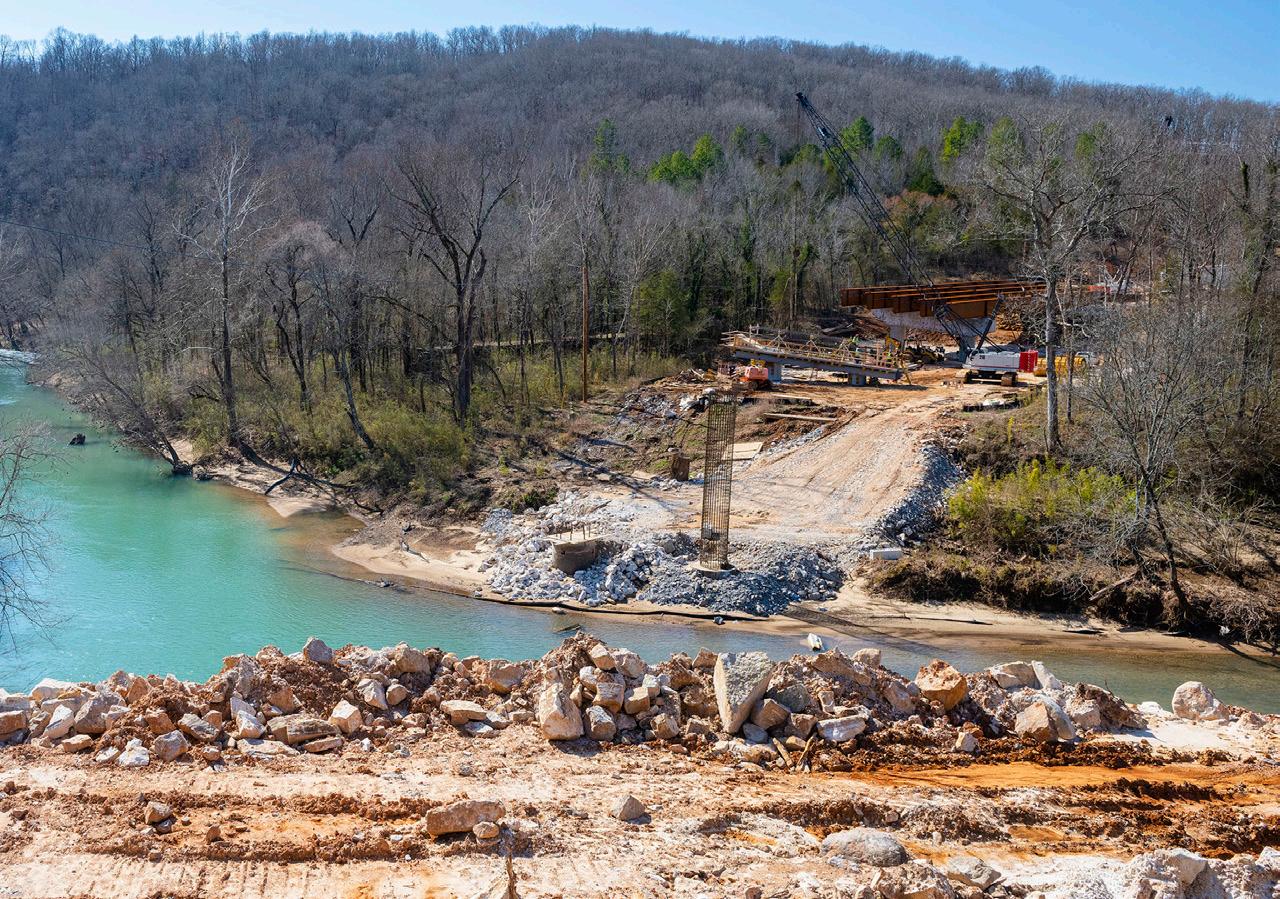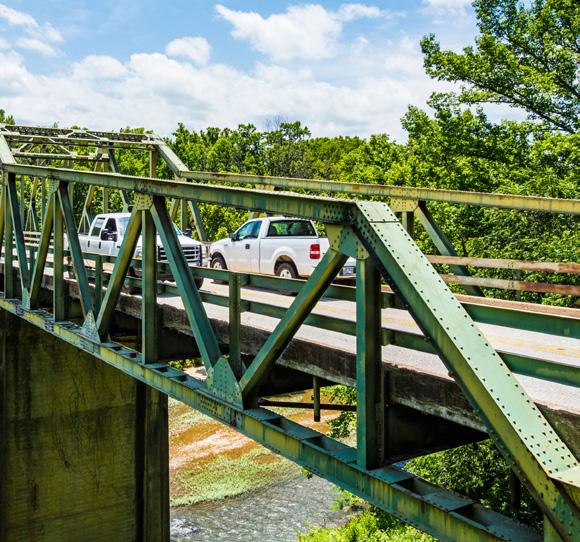
6 minute read
A National Treasure Runs Under It: Bridge Construction over the Buffalo
A National Treasure Runs Under It: Bridge Construction over the Buffalo BY DAVID NILLES
MOST ARKANSANS WOULD AGREE THAT THE BUFFALO RIVER IS ONE OF ARKANSAS’ SPECIAL TREASURES. Making its way through the Ozark National Forest of northwest Arkansas, it is a place of untouched beauty that attracts paddlers, campers and hikers from across the country.
Because the river is loved by so many, it was designated the country’s first National River in 1972. This special status protects the river from commercial or residential development or any other destructive operations.
When the time came to replace the State Highway 7 Bridge over the Buffalo River near Pruitt, ArDOT knew the bridge project would have to be handled with special care to protect the national river running below it.
HISTORY OF THE PRUITT BRIDGE Known as a landmark in Newton County, the Pruitt Bridge is a two-lane “Pennsylvania through truss” structure that was built in 1931 by the Virginia Bridge & Iron Company. It stretches 374 feet as it crosses over the Buffalo and carries 2,400 vehicles a day. It was named to the National Register of Historic Places in 1990. The unique bridge has served its purpose well over the past 89 years, but time and traffic have taken their toll on the structure. “The old bridge is in very poor condition and is too narrow for today’s traffic,” District Nine Engineer Steve Lawrence explained.
ENVIRONMENTAL CONSIDERATIONS FOR A NEW BRIDGE
Because the Highway 7 Bridge is located over a national river, plans for a new structure required not only bridge design considerations but extra environmental considerations as well. The Environmental Assessment for the new bridge project weighed heavily with ArDOT staff. “The Environmental Assessment and Least Overall Harm Section 4(f) Evaluation we prepared for the project identified a number of measures that had to be considered,” stated Mary Pearson, an Environmental Impact Specialist for ArDOT.
Section 4(f) is part of the Department of Transportation Act of 1966 that was passed to protect public parks, recreation areas, wildlife/waterfowl refuges and important historic sites from being harmed by transportation projects. “Because there were multiple project alternatives and several Section 4(f) protected resources in the project area, the Federal Highway Administration (FHWA) requested that we follow the Least Overall Harm Section 4(f) evaluation procedures,” Pearson explained.
In such a situation, FHWA may approve only the alternative that causes the least overall harm in light of the preservation purpose of the statute. (continued on page 28)
The new bridge is expected to be completed in 2020.
According to Pearson, “This was the first time ArDOT had used the ‘least overall harm’ evaluation procedures, and we worked very closely with the Park and State Historic Preservation Office personnel to determine the relative significance of the protected resources, how to reduce impacts and consider mitigation measures. This was a complex process given that the Park has so many protected features, qualities and activities that make it important for recreation.”
Historic sites that are on or eligible for the National Register of Historic Places and therefore considered stand-alone Section 4(f) projects were also in the project area. The Section 4(f) evaluation went through a rigorous FHWA legal sufficiency review, a public comment period in conjunction with the Environmental Assessment (EA), and ultimately identified the preferred alternative. Options for the Buffalo River bridge replacement project underwent a variety of considerations for several years. Among them was combining it with a passing lanes job, or combining it with the Mill Creek bridge replacement project nearby. Separating it from other projects was also considered, but the final decision was to replace the Buffalo River Bridge and the Mill Creek low water crossing as a single project.
“The EA and Section 4(f) evaluation process took approximately four years,” Pearson shared. “It involved preparing a preliminary draft, a completed draft and final documents with review periods and agency coordination meetings at each stage.”
Because the Pruitt Bridge is considered unique to nearby residents, ArDOT also held a public meeting prior to construction to gain input from residents living in the area.
BUILDING THE NEW BRIDGE The new Buffalo River Bridge is being constructed 200 feet east of the old bridge. It will be 45 feet wide and include a five-foot wide sidewalk on one side. Instead of 10-foot traffic lanes, the new bridge will have 12-foot lanes and include 8-foot shoulders.
Construction of the new bridge began in early 2019. The project was awarded to Crouse Construction of Harrison for $13.5 million. “The contractor is making good progress on both of the bridges and their approach work,” Lawrence added. “Most of
The previous bridge served its purpose for 89 years.

the foundation work is complete, and work is currently being done on the columns and caps of the substructure.”
The Environmental Assessment and “Least Overall Harm” Section 4(f) prepared for the project identified a number of visual impact mitigation measures. Among them was the design of the bridge.
ArDOT staff members Jim Pool and Luke Bailey, Bridge
Design Engineers in the Bridge Division, coordinated with Park personnel in selecting the new bridge’s architectural finishes and colors. A patterned form liner, used to produce detailed textures reflective of the rock formations in the area, will be used on the pedestrian and traffic barrier railings. Weathered steel and earth-toned concrete stains were also chosen to help the bridge blend in with the natural surroundings.
PROTECTING THE RIVER BELOW AND THE SURROUNDING AREA With the knowledge that the bridge is being constructed over a national river, special considerations had to be made to ensure protection of the river and surrounding environment. That began with clearing for the project. “The endangered Indiana bat and threatened Northern long-eared bat potentially live in the project area,” Pearson explained. “To prevent disturbing these bats during their active season as they’re foraging and roosting in the surrounding forests, tree-clearing is prohibited from March 15 through November 14, and construction activities are prohibited one hour before sunset and sunrise. Blasting operations are also prohibited between November 30 and March 15 to avoid disturbing their hibernations in nearby caves.” Special monitoring of the river’s water quality was the role of the Stormwater Section of the Environmental Division.
“The Buffalo River’s status as an Extraordinary Resource Water requires turbidity monitoring during instream construction activities,” Pearson added. “Sarah DeVries and Lindsay Zweifel in our Natural Resources section trained the construction contractors and provided equipment so monitoring can be carried out as needed.” Work along the river’s shoreline also had to be considered. Native stone riprap (rock used to stabilize shorelines) will be used to prevent the visual disruption that standard riprap can cause in settings such as the Park. The riprap voids will be composted and planted with special grass and seed mixes to assist with native re-vegetation and further naturalize its appearance. “Plating rock fill areas and ditch liners with native stone also helps retain the Park’s natural appearance,” Pearson added.
Special seeding requirements had to be put into place including minimizing the disturbance of native vegetation and ensuring that re-vegetation includes only native species.
“We are replanting areas with native grass and wildflower seed mixes, and following procedures to prevent introducing non-native or invasive species. A 50-foot vegetated buffer zone was also established along the river to protect both the riparian area and the Buffalo River’s water quality.”
Estimated completion of the new bridge is expected at the end of 2020. The existing bridge will be removed once the new bridge is open to traffic. Though the area will lose a bit of history, it will enjoy a brand new bridge, one that blends in well with the waters of the Buffalo.










